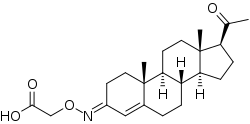Progesterone carboxymethyloxime
Progesterone carboxymethyloxime, or progesterone 3-(O-carboxymethyl)oxime (P4-3-CMO), is a progestin which was never marketed.[1][2][3] It is an oral prodrug of progesterone with improved pharmacokinetic properties.[1] The compound was developed in an attempt to address the poor oral pharmacokinetics of progesterone, including its very low bioavailability and short biological half-life.[1][2] These properties of progesterone are thought to be caused by its low water solubility and high metabolic clearance rate due to rapid degradation in the intestines and liver.[1][2] Drugs with low aqueous solubility are not absorbed well in the intestines because their dissolution in water is limited.[4]
 | |
| Clinical data | |
|---|---|
| Other names | P4-3-CMO; Progesterone 3-carboxymethyloxime; Progesterone 3-(O-carboxymethyl)oxime; 3-(O-Carboxymethyl-oximino)progesterone; [[(20-Oxopregn-4-en-3-ylidene)amino]oxy]acetic acid |
| Routes of administration | By mouth[1] |
| Drug class | Progestogen; Neurosteroid |
| Identifiers | |
IUPAC name
| |
| CAS Number |
|
| PubChem CID | |
| ChemSpider | |
| ChEBI | |
| ECHA InfoCard | 100.164.875 |
| Chemical and physical data | |
| Formula | C23H33NO4 |
| Molar mass | 387.52 g/mol g·mol−1 |
| 3D model (JSmol) | |
SMILES
| |
InChI
| |
P4-3-CMO (as the potassium salt) showed water solubility that was increased by more than four orders of magnitude relative to progesterone (solubility = 9.44 mol/L and 0.0006 mol/L, respectively).[2] In addition, it showed an in vitro terminal half-life in rat liver microsomes that was 363-fold longer than that of progesterone (half-life = 795.5 minutes and 2.2 minutes, respectively).[1] As such, P4-3-CMO could have both improved absorption and increased metabolic stability relative to progesterone.[1][2] However, the compound has not been further assessed nor studied in humans.[1][2]
See also
References
- Basu, Krishnakali; Mitra, Ashim K. (1990). "Effects of 3-hydrazone modification on the metabolism and protein binding of progesterone". International Journal of Pharmaceutics. 65 (1–2): 109–114. doi:10.1016/0378-5173(90)90015-V. ISSN 0378-5173.
- Basu, Krishnakali; Kildsig, Dane O.; Mitra, Ashim K. (1988). "Synthesis and kinetic stability studies of progesterone derivatives". International Journal of Pharmaceutics. 47 (1–3): 195–203. doi:10.1016/0378-5173(88)90231-1. ISSN 0378-5173.
- Singh H, Jindal DP, Yadav MR, Kumar M (1991). "Heterosteroids and drug research". Prog Med Chem. 28: 233–300. doi:10.1016/S0079-6468(08)70366-7. PMID 1843548.
- Ron Liu (18 January 2008). Water-Insoluble Drug Formulation, Second Edition. CRC Press. pp. 105–. ISBN 978-1-4200-0955-2.